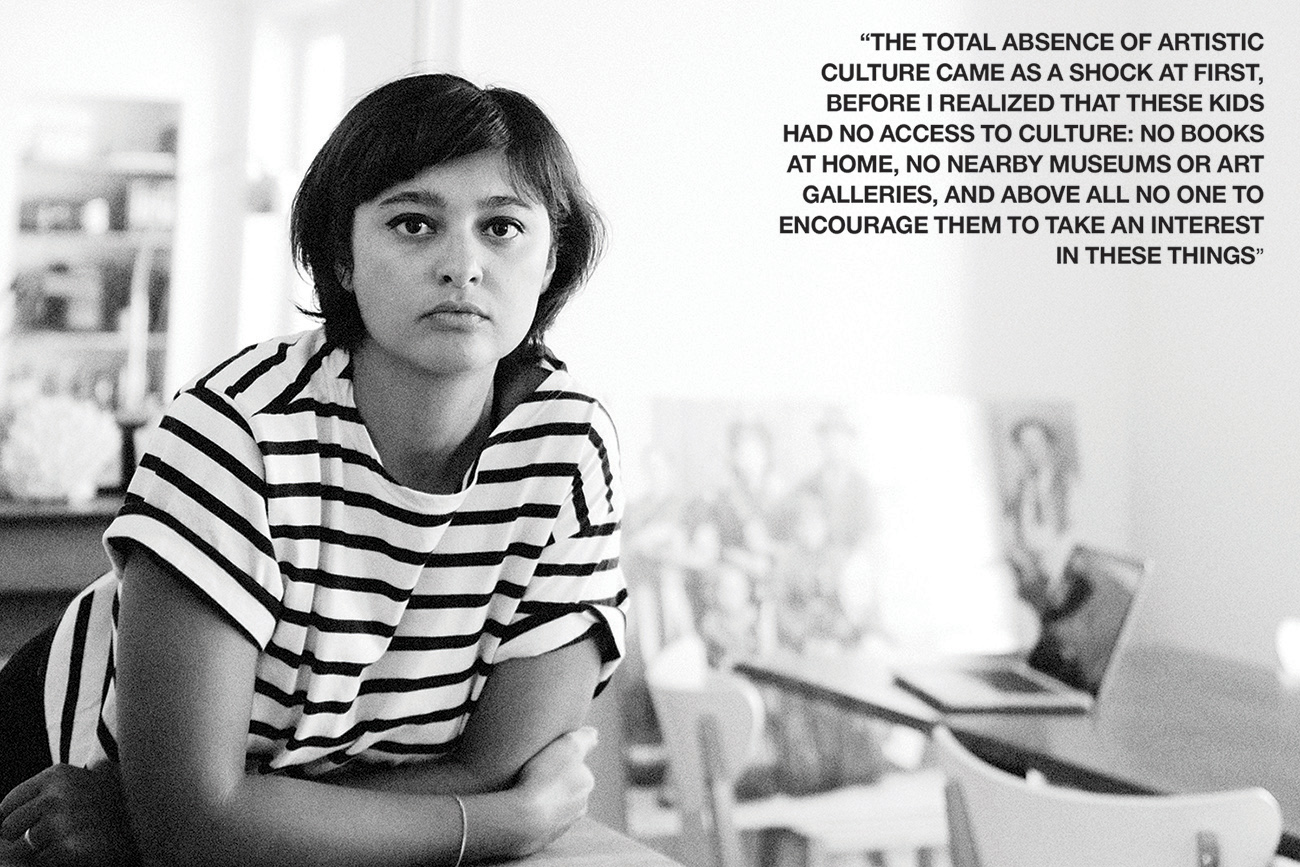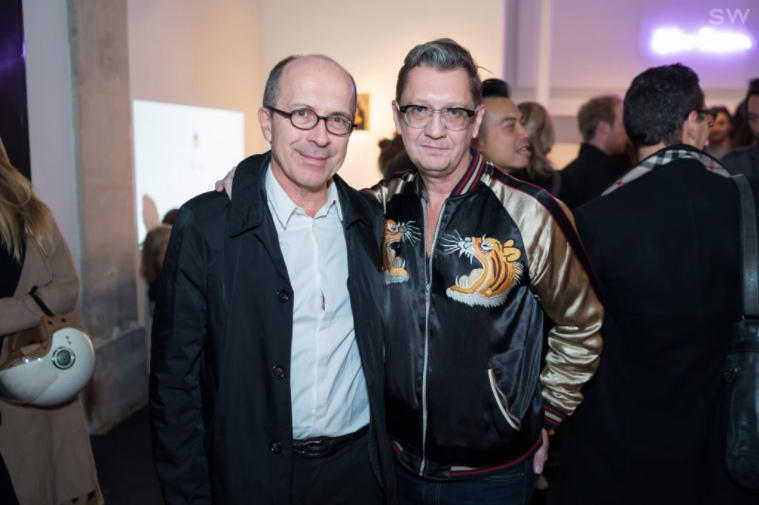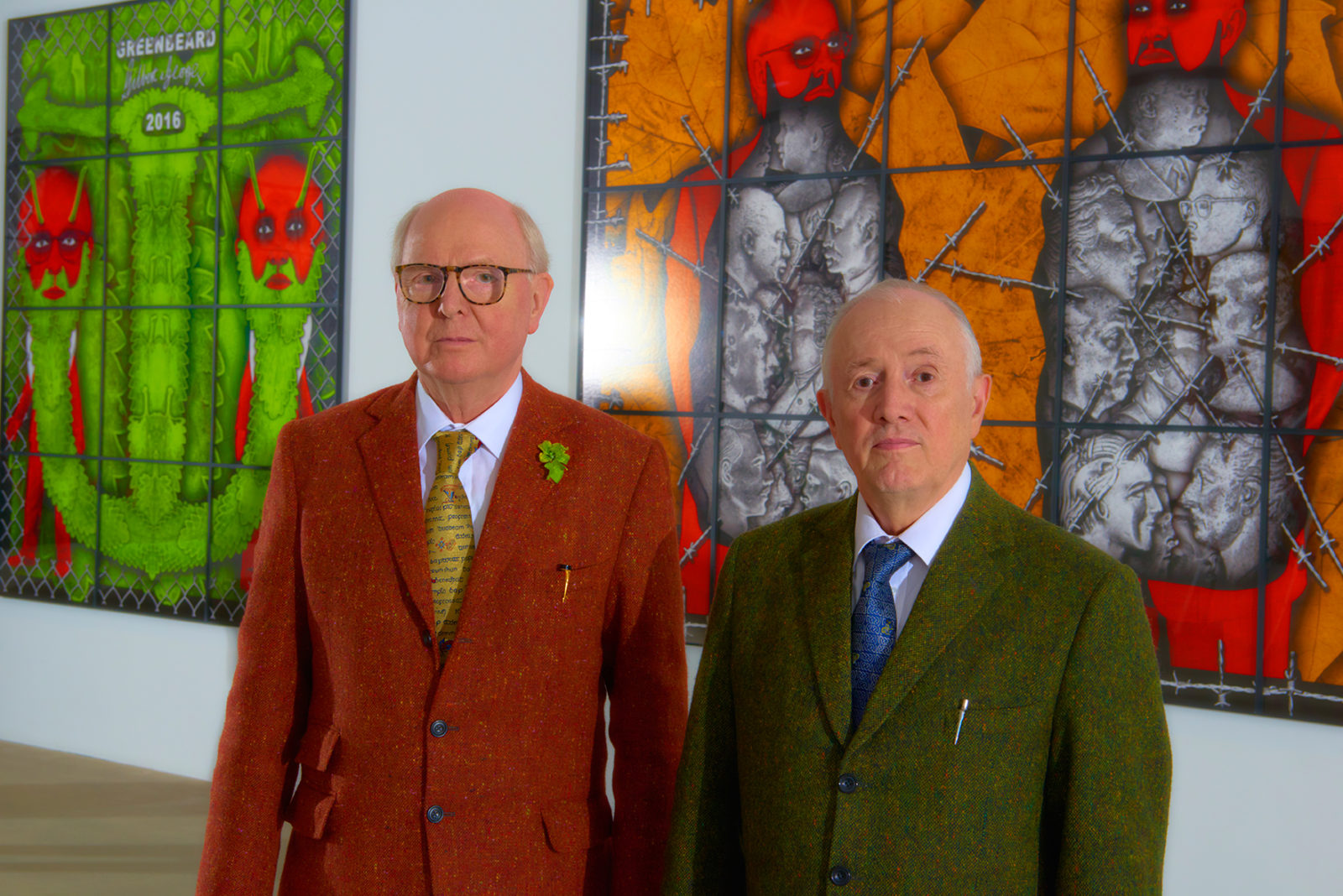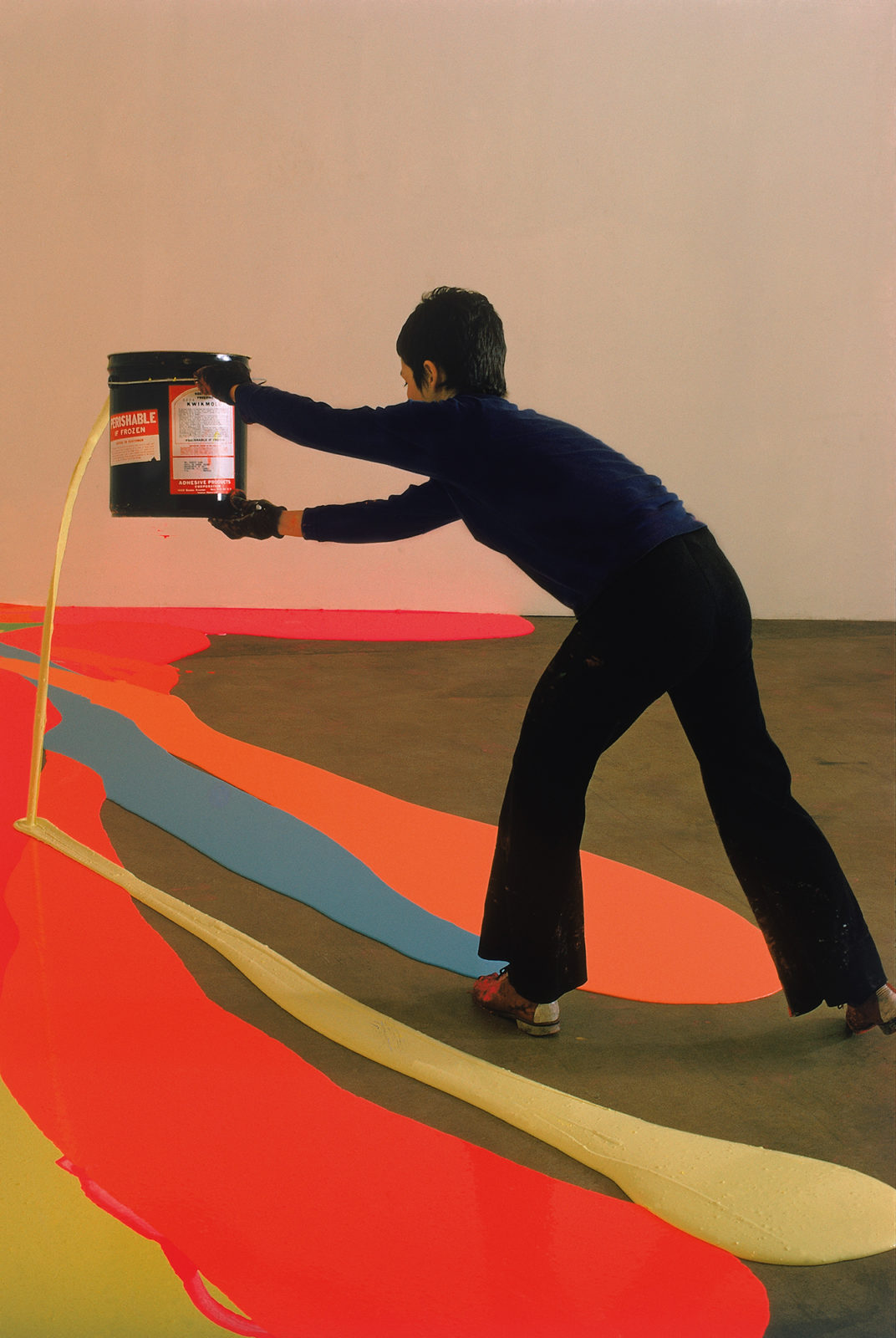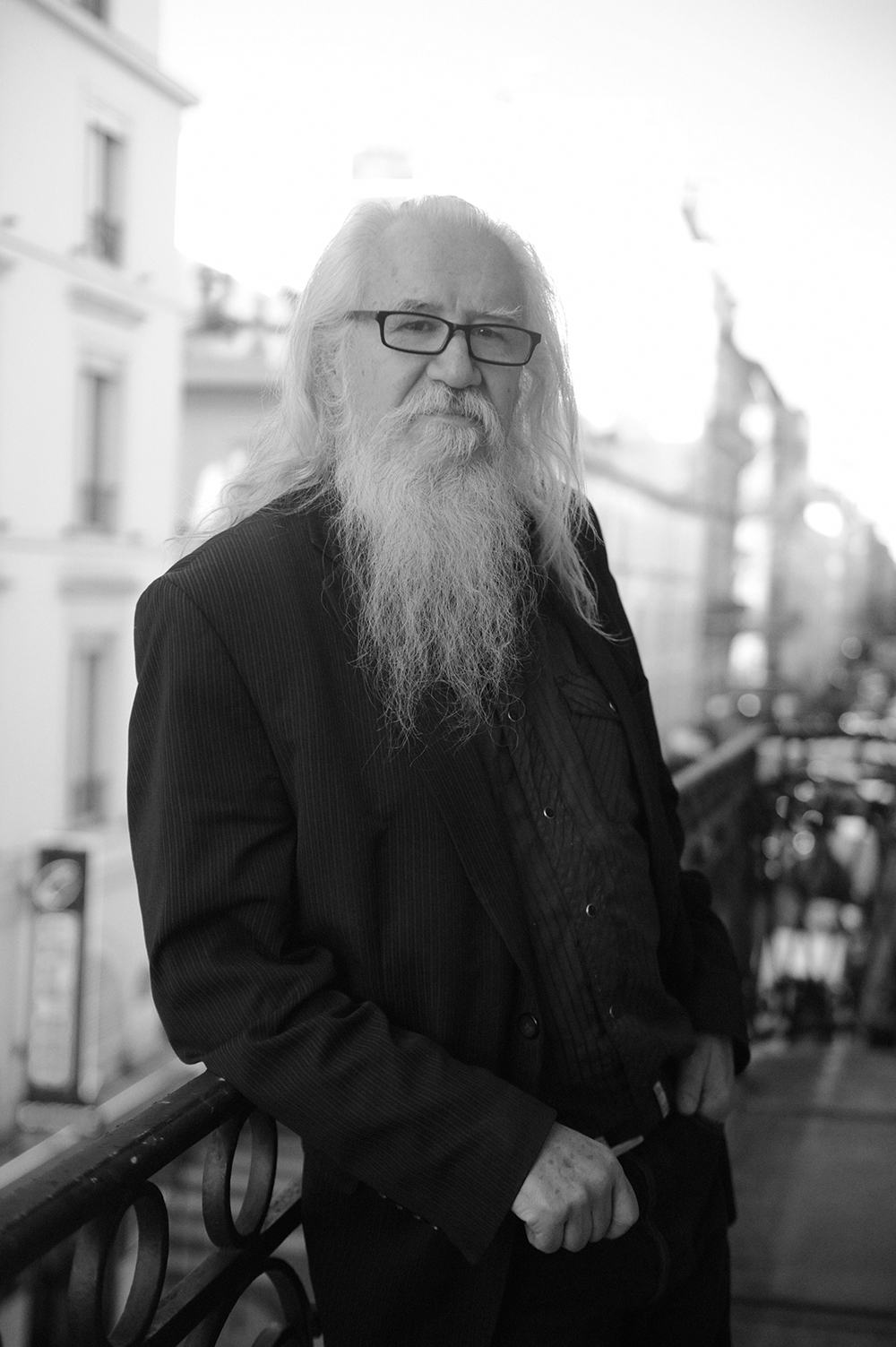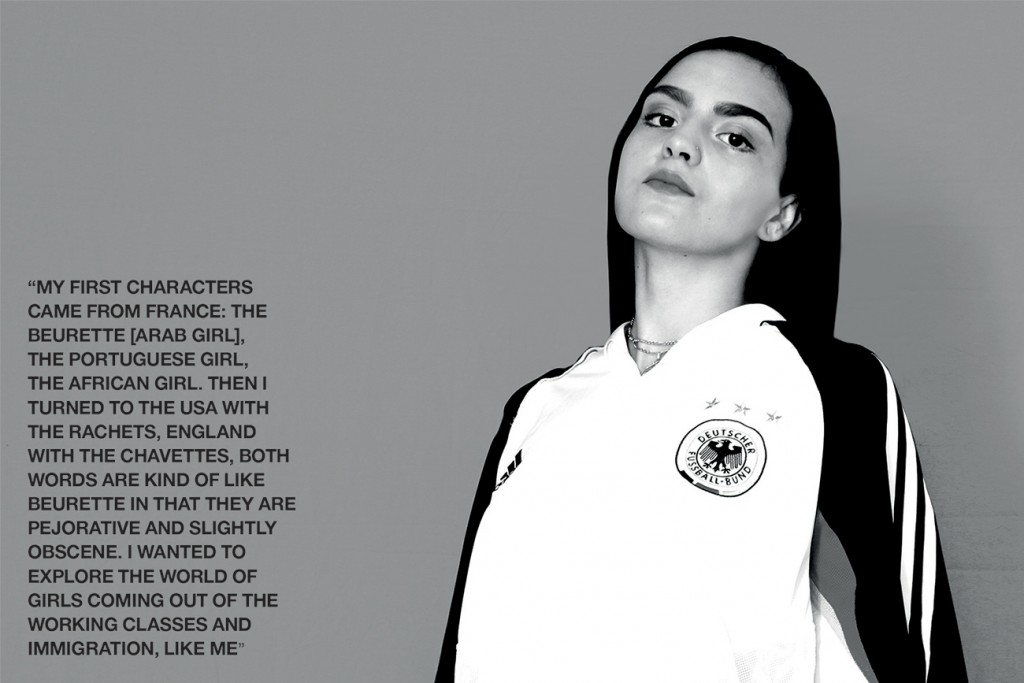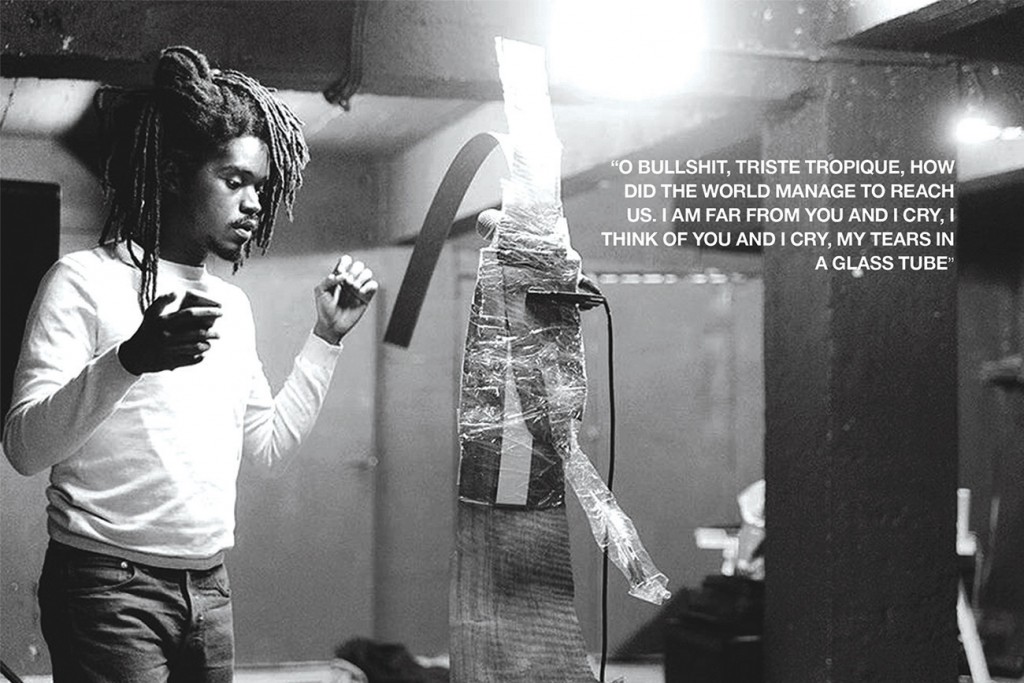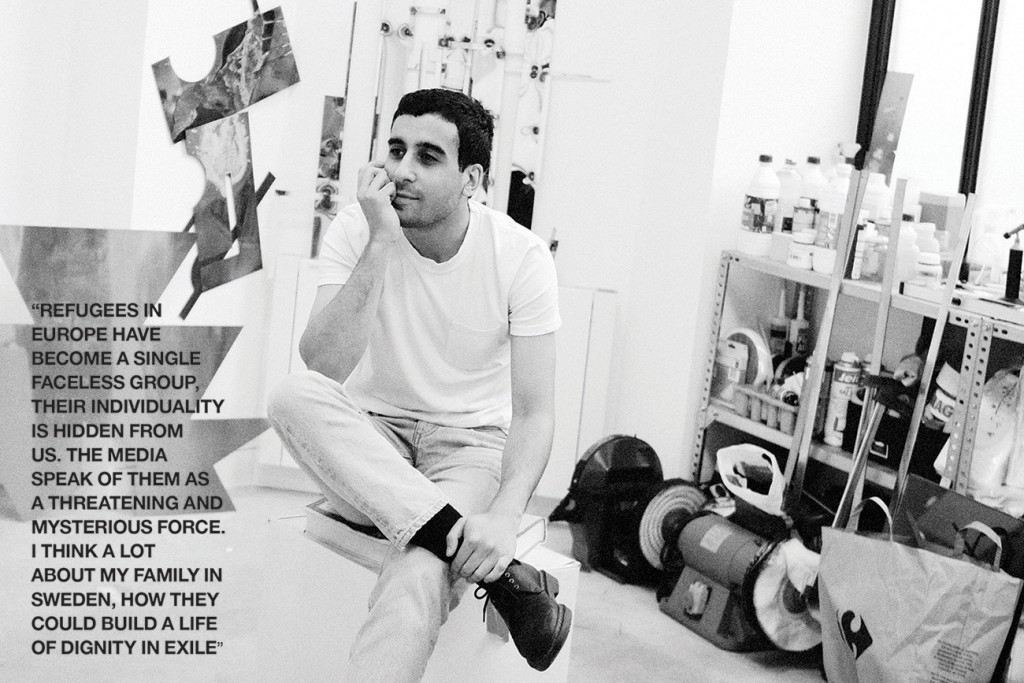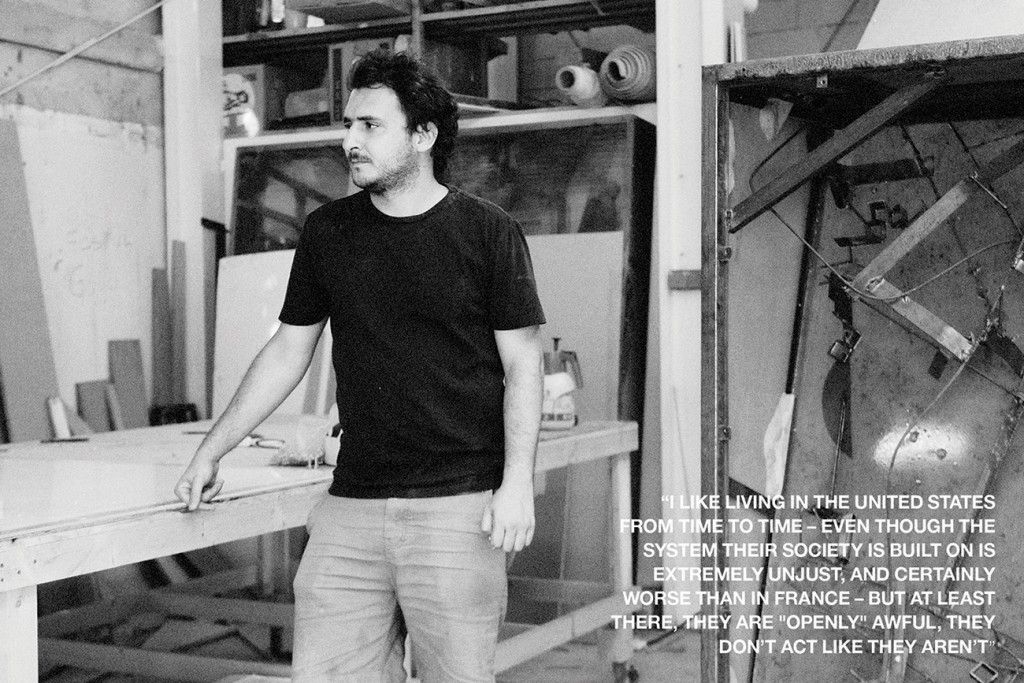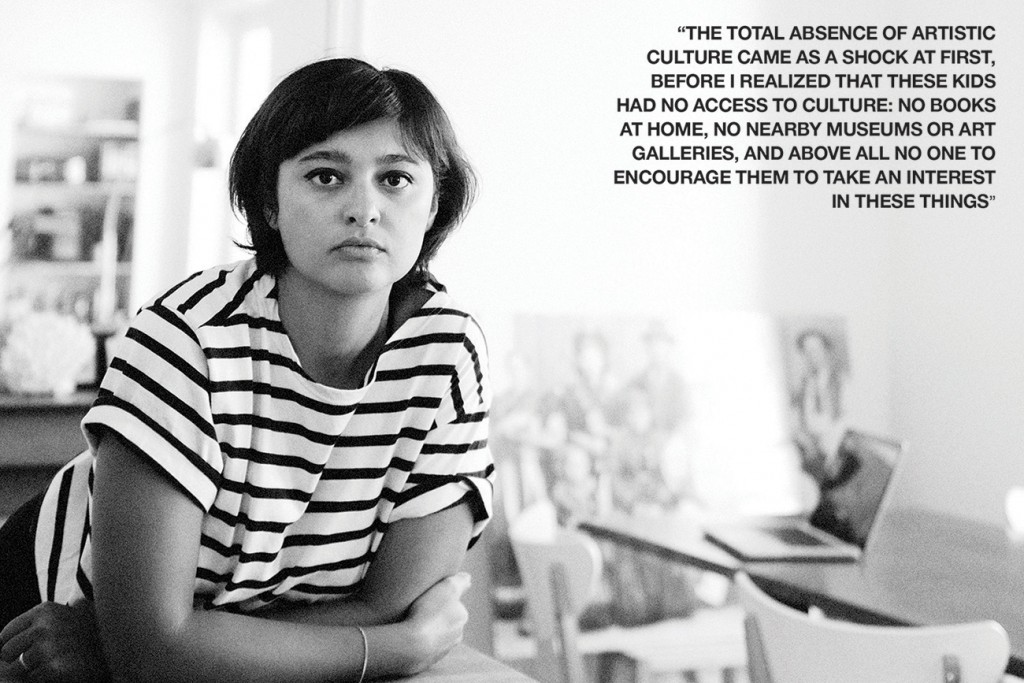
PARIS AFTER THE BOMBS: MEETING A NEW GENERATIONS OF ARTISTS
By Crash redaction
PARIS AFTER THE BOMBS : MEETING A NEW GENERATION OF FRENCH AND INTERNATIONAL ARTISTS
In the post-attack landscape in Paris and across France, 6 young French and international artists – some the products of immigration – continue to live their lives and make art. We sat down with these fierce personalities for a frank discussion about how art can offer a small but powerful response to fear and stereotypes. Interviews by Dorothée Dupuis – Crash 77 From Paris with Love
KATIA KAMELI
Katia, we have known each other for ten years, and we saw a lot of each other in Marseille, where you worked and I managed the Triangle France art center for five years. Your father is Algerian, but you grew up in France with your mother after your parents divorced. Can we say that your video work takes a documentary approach, though, since your films are often presented as installations, it is firmly rooted in contemporary art?
Yes, in a certain sense we can say that: in my own life I’ve often had to juggle between two cultures, I was always asked to take sides, and I never thought it was fair. Instead it seemed reductive, as though it weren’t possible to have more than one way of interpreting things. So I refuse to get too arrogant about those questions. I argue for the idea of the liminal; you can reinvent situations, reinterpret them. Documentaries are about information. It’s an open question, because all information contains an element of fiction – which is very clear on social media! There are a lot of degrees.
I discovered Marseille in 2003, just after directing “Bledi un scénario possible.” I spent a month in Algeria shooting that film. In “Bledi” I was trying to understand a situation: there are very few images of Algeria during the period of terrorism. I also wanted to question the medium of video, which I knew I was going to be using very frequently (I graduated from art school in Bourges in 2000), so there are still images, moving images, black-and-white, color, Super 8… When you have a camera in your hands, you are also an actor, whether you smile or not tells people whether you are cool or aggressive, when you capture images, you have a hand in making that image, you are not just capturing reality. As soon as there is a camera, the situation is altered. I had to adapt in Algeria: at first I didn’t want to lower my eyes, but after a while I got tired of being harassed, so when I got back to Marseille I realized that I was still walking with my eyes on the ground… Marseille, which is often compared to Algiers, was like a decompression chamber for me before going back to Paris.
You have been grouped in with a community of Arab artists. Do you even have a sense that a real community exists among this group? Does that force you to take more of a political position in your work than other artists might?
I turned to art because I think of it as political, though in an indirect way. Oddly I fell into the Arab category by way of Africa, where my work was shown much more often than in North Africa or the Middle East. Since I was interested in Algeria… It’s true that my recent work on the Fables of La Fontaine might take more of a political stance. I’m tackling a monument of French culture by following the lessons of several researchers who have told us about the Indian and Middle Eastern origins of these fables. I want to show that France’s cultural roots stretch far beyond Europe, and that they are not monolithic but multicultural. That project grew out of my being sick and tired of hearing absurd isolationist discourse, on both sides.
It’s important today, when we try to single out any culture, to remember that things are not so simple and that there have long been cultural influences in many directions… And I don’t even need to recall that La Fontaine took inspiration from the Greeks, because we all learn that in school. Art serves that purpose, like literature: to interpret things according to your own personal filter. If I read The Stranger by Camus I’m not going to have the same interpretation as you: there are no unilateral interpretations in art. Art allows us to break free from dictates.
SARA SADIK
Sara, you are 21 years old. You are French, your father is Moroccan, and your mother is Algerian. You are a student at the art school in Bordeaux, but you are already exhibiting your work outside of school. I attended one of your performances at Le Magasin in Grenoble in 2014. Your work parodies clichés about immigrant working classes in France and in other Western countries like the United States and England. Can you tell us about your background and your work?
I’m from a housing project near Bordeaux. I was supposed to go a ZEP high school, but I didn’t want to go there, so I looked for a way to go to high school in the downtown area, and so I signed up for the applied arts curriculum, to get out of my school district, and it worked. That’s how I started making art. Then I went to the art school in Bordeaux and that’s where I decided to talk about my early life: the life of a girl who fought guys, listened to rap and hip hop all day long, and watched nothing but reality TV. I made a web series about two best friends of Moroccan and Portuguese origin, based on me and an actual friend of mine. All of my videos are very short and inspired by TV: I made a fake news shows that send up all the stereotypes of black girls in American ghettoes. My first characters came from France: the beurette [Arab girl], the Portuguese girl, the African girl. Then I turned to the USA with the Rachets, England with the Chavettes, both words are kind of like beurette in that they are pejorative and slightly obscene. I wanted to explore the world of girls coming out of the working classes and immigration, like me.
Oddly I made friends right away at the bourgie high school in downtown Bordeaux. In my mind they were all rich people: I hung out at their houses, and then when I went back to my parents’ apartment in the housing project, I realized I never wanted to come back. In fact, one month after school started I cut off all contact with my friends from before high school. It was even easier because my parents moved to another neighborhood at the same time. I deleted my Facebook profile and created a new one: I rebuilt everything online. Sara Sadik from grade school didn’t exist anymore. From time to time I still run into one of my best friends from that time in downtown Bordeaux, but we just say a quick hello and go our separate ways. I swept everything away and I don’t regret it.
I don’t think I was made for that kind of environment. I watched TV and I wanted to be a star. When you’re young, you want to get out, make money, have a house, be a success – not end up at McDonald’s. I think anyone could have done what I did. But I don’t know what other people are dealing with. Not everyone wants or can do it. I had the desire, I seized my opportunity, and good for me. None of the girls in my stories does any better than any of the rest, but I love the power of imagination: making up their lives and characters, even if it all stays pretty close to stereotypes and real life, while focusing a lot on appearances, surface…
There aren’t many people from my kind of background at my school, maybe four or five, but I don’t know everyone. Some students come from the countryside, but that’s different. It’s better that way for me. I have something different to offer and I can set myself apart from the other students. One day I’d like to work for a reality TV show, just to see, since it’s fascinating to me. And I’d also like to finish school, work on my thesis, continue my art projects, notably by developing the character of Melissa Lacoste, who is an R&B singer, a sort of amalgam of my research on the beurette. I hate that word, but I make use of pejorative words by pairing them against the value I give to my character(s).
JULIEN CREUZET
When I sent you my first email, you immediately replied with a poetic text that is now part of a work you recently presented at Galerie Doyang Lee in Paris, consisting in a sculpture and an unusual title in the form of a poem of over 30 lines! I wondered what you wanted to say with this poem, which is very abstract but it seems to be about a Rastafarian homeless man that you knew or met… In the poem you evoke a lot of the visual elements that are also present in your artwork, and which describe a sensory, human, and political experience. It’s also a violent poem because the black man it talks about seems to function as a sort of alter ego, a fallen double of yourself – a young black man between France and Martinique – an allegory for a possible social and civic “demotion,” to borrow the term from Tarik. You live in the chic center of Paris, where it’s a shock to see destitute individuals, but you have also exhibited and worked in the disadvantaged areas outside Paris, collaborating with different people and interacting with various audiences at art centers. What is really going on in our cities, both in the center and the outskirts? What is normal or unusual to see?
The homeless guy is a crack addict. He is more so dirty from life, than religious and Rasta. It’s strange, but there’s an important distinction. He never believed in Jah, he just did what all his friends did, smoking joints from an early age. He smoked very young without knowing, black smoke, from the burning stone. The joint was black. A hit, empty glass, coin after coin.
From Martinique, the metropolitan outskirts, he arrived dirty in the hallways of Strasbourg-Saint-Denis, between the 9 and 4 lines. It’s electric, things happen, human eyes do not want to see the same things. I see through my filter, sincerely, tristes tropiques, and that’s no intellectual tourist bullshit.
The earth turns and is deformed by bombs, the man is a little bear, who thinks he can be a lone wolf. It’s poverty and an empty pot. It’s brown sugar, that was left to burn by inertia. I pull the trigger, I pull hard, the force of my forearm, machete in hand. You and me, we have the same eyes, which examine this violent world. My tattooed skin is an all over, an overdose, each coin spent immediately, on the subway platform. This image is my escape and my present, this image is my toxic here.
O bullshit, triste tropique, how did the world manage to reach us. I am far from you and I cry, I think of you and I cry, my tears in a glass tube. It’s a black hole in a roundtrip that goes too fast. My mouth and my nose, my eyes ready to explode. This stone that crackles, the diamond that slides along the black plastic of vinyl. We fired up some coke.
SALMA CHEDDADI
Salma, you are a young Moroccan (now French!) artist and you’ve lived in France for fourteen years. You produce films featuring mostly female characters involved in more or less realistic stories, in which fantasy – and often eroticism – generates a close connection between the protagonists and the surrounding landscape, everything taking place through an intimate relationship with the camera, and so you, the director, without the viewer ever knowing if they are witnessing a fictional or voyeuristic process, something akin to documentary. You were in Morocco during the attack in Nice, and you told me that people lamented the actions by saying: a’oudou billah mina al shaytan ar-rajim (“I seek protection from God against Satan”). During our phone conversation, you notably mentioned two things: the rising tide of social conservatism and religion in Casablanca, which is threatening the place of women in public space at an alarming rate; as well as your traumatic experience in France as an artist leading a social workshop in the “no (wo)man’s land” of the Paris outskirts, working with kids whose delinquency you describe as a result of abandonment and violence – both from the state and their parents. Can you talk more about those issues in your own words?
When I left Casablanca in 2002, at age 17, to come study in Paris, I was aware that “making art” was a political act. Making films from a female perspective and wanting to create images full of poetry and sensuality, or even just thinking about the world through the filter of art, already served as a kind of statement. The social landscape in Casablanca has certainly shifted in recent years, as though the rise of conservatism has accompanied the arrival of shopping malls in La Corniche. A majority of women now wear veils, and it has become a common occurrence to be publicly harassed for daring to wear a skirt to the market or a bikini to the beach. Public space is a male space that women must enter with discretion. This growing tide of oppression is tolerated to a dangerous extent: the authorities rarely prevent it, and religious conservatism encourages it in working-class neighborhoods. There is no mystery about how to counter obscurantism: we have to educate young people in tolerance and acceptance; but little space is set aside for art and what few cultural centers we have left are rarely visited. In the area surrounding Paris, the context is different but the problem is similar: during the film workshops we led between 2012 and 2015 at grade schools in Seine-Saint-Denis (commissioned by the regional administration), I met a lot of young people from chaotic backgrounds, who were sometimes violent and estranged from school. The total absence of artistic, cinematic, and literary culture came as a shock at first, before I realized that these kids had no access to culture: no books at home, closed or inaccessible movie theaters, no nearby museums or art galleries, and above all no one to encourage them to take an interest in these things. The actions undertaken by the regional council and my presence, along with the dozens of other artists working in different programs, has an impact on these young people, but the audience is so small and the duration so short that it cannot possibly have a meaningful impact. We need to set aside more room in curricula for art and culture, which offer us some of our most powerful tools for understanding our history and the past, notably the colonial past… Culture is always relegated to the back burner, yet now it seems like our most urgent priority.
TARIK KISWANSON
Hi Tarik, and thanks for answering my questions. You are the child of Palestinian refugees who went to Sweden in the 70s. You finished art school in Paris, where you still live today. I was hoping you would talk a bit about your experience as a young foreign artist in Paris, and if you had any thoughts about what is happening right now in France and Europe.
I’m answering your questions from Amman, Jordan, where my mother has a house. I am in fact of Palestinian origin, from a village called Beit Iksa, very close to Jerusalem, where my grandfather was a postmaster. When the war threatened his family’s safety, he decided to go to Amman. Much of my family still lives there and I have visited often since childhood. My parents immigrated to Sweden in the 70s. My father was fed up with war and was attracted by the expansion in glass production – his profession – in the south of Sweden. He left in hopes of developing his career as an artist, and managed to bring my mother along several years later. They met in Jerusalem. It was a different time: there was enough money to help the integration process for immigrants, who also arrived in smaller groups. My mother and father, like my grandfather, also bought land in Jordan to build this house, there was nothing here, only desert. Jordan has no resources like oil or minerals, which saved it from becoming an economic target for its neighbors. Jordan lives off the tourists who come to see its archaeological sites, the Dead Sea, the Red Sea, and the fact that it has become the only stable country in the region – just a few hours from Jerusalem, Beirut, and Damascus! For the last fifteen years, Amman has become the top destination for foreigner with business interests in the region. Amman looks a lot like any major Western city. Women enjoy true independence here, while Christians and Muslims live side by side in peace. It’s strange to think that most of the region was like this just 50 years ago.
I started school in London in 2006. London is a city of immigrants, and so it values a diversity of styles. At Saint Martin School, 80% of students were foreign! Imagine my surprise when I went to Paris for my Masters of Fine Arts and it was the opposite, 80% of students were French, despite the fact that Paris is just as much a city of immigrants as London. But you notice the segregation right away in Paris. I quickly realized that there were two groups at school: foreigners who stuck together because they didn’t speak the language – and the French. Though interactions between these groups sometimes took place, there was still a profound difference. I decided to learn French, less for art school and more to integrate into French society in general… France is extremely chauvinistic when it comes to language, they don’t really want to speak English… It’s strange that alongside this rich and open tradition of art and philosophy in France, the daily culture is extremely closed and self-involved. The French need to work on themselves, and on their colonial past. All of Europe needs to do the same.
And yet, I’m not idealizing England: they notably oversaw the creation of Israel – and that has a real impact on my life, and the life of millions of people, my people. Refugees in Europe have become a single faceless group, their individuality is hidden from us. The media do not speak of them as people, with stories, professions, dreams, families, but as a threatening and mysterious force. I think a lot about my family in Sweden, how they could build a life of dignity in exile. These people are going to face a major demotion, an unacceptable change in their personal situation in Europe and that breaks my heart. Fleeing war in your home country is something you do because you have no choice, and Europeans need to recognize that fact.
NEIL BELOUFA
Neil, you are French and born in Paris to Algerian parents, but you grew up between Paris and Algiers (which you visited frequently) until you were 6 years old. You studied art first in Paris and then in Los Angeles – the United States welcomed you with open arms because you are represented by François Ghebaly Gallery (Los Angeles), and you currently live in New York, where you showed your work at MoMA this year. Your art notably evokes the way technology alters our perception of the world within works that blend sculpture and video. The characters present in your art constantly “situate” each work in an implicit way. I also see your art as containing a certain “hood” energy, a force that is multiracial, male, adolescent, and vaguely menacing, which functions as a screen, reminding us that technology is also a tool for exclusion. Can you talk a little about that in the context of the current situation in Europe and what it is like to be a young North African in Paris after the attacks?
I’m not sure I’ll have the best answers for your questions! But we can try. For my social and cultural background, I’m from a mix of the middle class and bourgeoisie of Algiers, I didn’t grow up in the suburbs. So the “hood” side, even though it is an integral part of my culture – and definitely of my vocabulary! – does not really correspond to my background. To answer your question, there is a phenomenon that I think is reemerging today and that reminds me of something I already felt in the mid-90s, without really knowing what it was. Maybe it was just my adolescence, but I remember that suddenly my North African identity became extremely apparent: that I had to assert it or justify it – though I was already well integrated, so that never played a big role before. I remember that at the same time, friends of mine asserted their identity as “feuj” (Jewish), though I didn’t know what that meant back then. All of a sudden, I had a Hand of Fatima around my neck, while one of my friends wore a Star of David; as though the failure of the French assimilation and secularism model reached my school overnight, or like the fantasy just vanished. I don’t know if those are actual memories or reconstructions, but I remember asking myself a lot of questions. What I’m about to tell you is just my own personal feeling. If even a person like me, who has the opportunity to travel all the time, who has resources, who speaks several languages, who is “assimilated” everywhere, if even I feel impacted and aggressed on a daily basis under the current climate; if when I want to use my Algerian passport instead of my French passport, I sometimes get stopped or searched in trains or airports; just imagine what someone without access to everything I have, someone less advantaged, less fortunate, coming from a social and cultural background similar to mine, imagine what that person must feel. They must absolutely lose their minds in today’s society – when I put myself in their shoes it all seems like garbage and it makes me terribly sad. I like living in the United States from time to time – even though the system their society is built on is extremely unjust, and certainly worse than in France – but at least there, they are “openly” awful, they don’t act like they aren’t. Essentially, your identity is not a problem as long as you (and your community) generate value for the system. There is a form of integration through business which is ugly but it makes it so that no one cares about who you are as long as you make money. Beyond that I’m just a “tourist,” and there, too, my point of view is only subjective. Nothing especially amazing, but nothing worse either.






